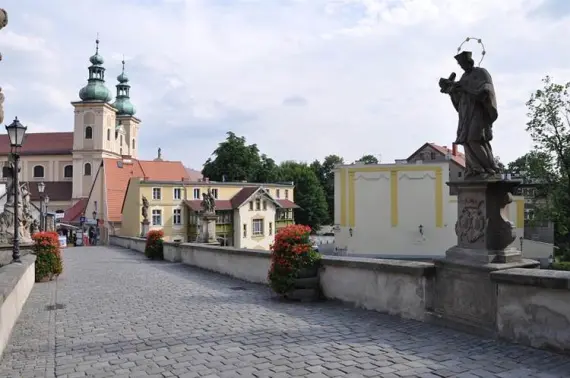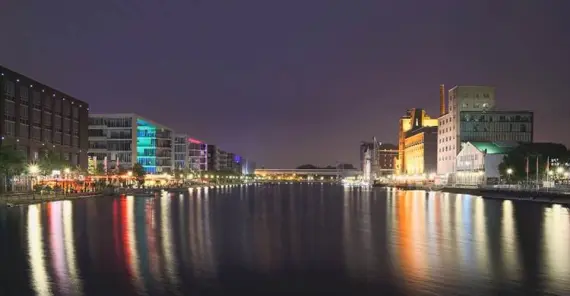Bus to DUISBURG from KLODZKO - timetable and current connections
KLODZKO

Klodzko is a town of less than 27,000 inhabitants in the Lower Silesian province, located in the northeastern part of the Klodzko Basin at the foot of the Bardzkie Mountains near the Polish-Czech border. It was first mentioned in the 10th century.
What do you need to see when visiting Klodzko? Monuments first and foremost, but its original medieval urban layout with colorful richly decorated townhouses and narrow and rather steep streets is also worth appreciating. Through which the Old Town captivates with its unique atmosphere.
The Klodzko Fortress, with its interesting tourist routes and the opportunity to admire the magnificent panorama of the city and its immediate surroundings, comes to the fore among visitors to the city. But what else is Klodzko famous for? Start your sightseeing with the Gothic Bridge over the Mlynowka River, often compared to Prague's Charles Bridge, and the interesting market square with its surrounding buildings. You should also take advantage of the interesting attraction of the Underground Tourist Route stretching in the former 13th-century cellars created under the buildings of the Old Town diversified with interesting historical expositions.
Getting to Klodzko
Klodzko is an important transportation hub for all towns in the district, with the E67 national road running through it. The city has a railroad station and several train stops within the city limits. Near the Klodzko City train station is also the Klodzko bus station, from which you can travel to numerous destinations in Poland and abroad. If you are planning to visit Klodzko - a bus can be a great and inexpensive choice. You can buy tickets for selected coach connections on our website.
Klodzko is a town of less than 27,000 inhabitants in the Lower Silesian province, located in the northeastern part of the Klodzko Basin at the foot of the Bardzkie Mountains near the Polish-Czech border. It was first mentioned in the 10th century.
What do you need to see when visiting Klodzko? Monuments first and foremost, but its original medieval urban layout with colorful richly decorated townhouses and narrow and rather steep streets is also worth appreciating. Through which the Old Town captivates with its unique atmosphere.
The Klodzko Fortress, with its interesting tourist routes and the opportunity to admire the magnificent panorama of the city and its immediate surroundings, comes to the fore among visitors to the city. But what else is Klodzko famous for? Start your sightseeing with the Gothic Bridge over the Mlynowka River, often compared to Prague's Charles Bridge, and the interesting market square with its surrounding buildings. You should also take advantage of the interesting attraction of the Underground Tourist Route stretching in the former 13th-century cellars created under the buildings of the Old Town diversified with interesting historical expositions.
Getting to Klodzko
Klodzko is an important transportation hub for all towns in the district, with the E67 national road running through it. The city has a railroad station and several train stops within the city limits. Near the Klodzko City train station is also the Klodzko bus station, from which you can travel to numerous destinations in Poland and abroad. If you are planning to visit Klodzko - a bus can be a great and inexpensive choice. You can buy tickets for selected coach connections on our website.
DUISBURG

Lying in the Ruhr region of western Germany, in the state of North Rhine-Westphalia, Duisburg is the twelfth largest city in the country. Duisburg is mainly associated with industry. Although you won't find many monuments there, by giving new life to numerous post-industrial buildings, the city is reviving and acquiring a unique atmosphere. Nowadays, the premises of former steel mills or factories house museums, art galleries or cafes, and everything is surrounded by lush vegetation.
What to see in Duisburg?
Duisburg stands with museums, so it is worth visiting at least one of them. Especially noteworthy are the Inland Navigation Museum and the Küppersmühle, dedicated to contemporary art. A major attraction in Duisburg is the Tiger & Turtle art installation, which resembles a roller coaster in appearance, but is a tangle of footbridges that you cross on your own feet. It is also worth seeing the city from the perspective of water, which is made possible by the rich offer of Rhine River cruises. Meanwhile, an attraction for the youngest will be a visit to Legoland, located about 15 kilometers from the city center.
Duisburg - how to get there
Less than 20 kilometers south of the city is Düsseldorf International Airport, and a little further afield is Dortmund Airport. Numerous highways run through Duisburg and its immediate vicinity. The city is also a significant railroad junction in this part of Europe - Europe's most important rail lines run through it. The Duisburg Hauptbahnhof central station is located in the very center of the city, and the main bus station is right next door, making it great for exploring Duisburg's biggest attractions in one day and moving on. If you're looking for Duisburg bus tickets, check the current connections in the search engine on the homepage.
Lying in the Ruhr region of western Germany, in the state of North Rhine-Westphalia, Duisburg is the twelfth largest city in the country. Duisburg is mainly associated with industry. Although you won't find many monuments there, by giving new life to numerous post-industrial buildings, the city is reviving and acquiring a unique atmosphere. Nowadays, the premises of former steel mills or factories house museums, art galleries or cafes, and everything is surrounded by lush vegetation.
What to see in Duisburg?
Duisburg stands with museums, so it is worth visiting at least one of them. Especially noteworthy are the Inland Navigation Museum and the Küppersmühle, dedicated to contemporary art. A major attraction in Duisburg is the Tiger & Turtle art installation, which resembles a roller coaster in appearance, but is a tangle of footbridges that you cross on your own feet. It is also worth seeing the city from the perspective of water, which is made possible by the rich offer of Rhine River cruises. Meanwhile, an attraction for the youngest will be a visit to Legoland, located about 15 kilometers from the city center.
Duisburg - how to get there
Less than 20 kilometers south of the city is Düsseldorf International Airport, and a little further afield is Dortmund Airport. Numerous highways run through Duisburg and its immediate vicinity. The city is also a significant railroad junction in this part of Europe - Europe's most important rail lines run through it. The Duisburg Hauptbahnhof central station is located in the very center of the city, and the main bus station is right next door, making it great for exploring Duisburg's biggest attractions in one day and moving on. If you're looking for Duisburg bus tickets, check the current connections in the search engine on the homepage.
© 2025 Sindbad
Technical support, assistance, payments: Sindbad IT
© 2025 Sindbad
Technical support, assistance, payments: Sindbad IT
